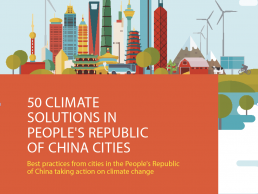First appeared in

Asian Development Bank
50 climate solutions from cities in the People's Republic of China
Constructing residential buildings to the highest standards in Qinhuangdao is cutting energy usage to a minimum and, simultaneously, creating better living conditions for residents.
To demonstrate how energy-efficient buildings can be built, Qinhuangdao has constructed four passive buildings totalling 28,050 square meters (m2) in a residential community named “Another Side of the River.” With the help of the German Energy Agency, a range of energy-saving measures have been adopted, including thermal bridge design, heat recovery system, renewable energy, heat insulation, and power saving devices. By following high German standards, the ultra-low energy buildings consume 90% less energy than the average building in the People’s Republic of China (PRC).
906
TONS OF CO2 EMISSIONS WERE REDUCED ANNUALLY IN THE PASSIVE BUILDINGS
The passive buildings have an “A” energy efficiency rating, and the primary energy demand of the building is just 110 kWh per square meter. The buildings were also constructed to create optimal living conditions for residents, taking into account the indoor temperature, relative humidity, and noise pollution. Given that buildings in the PRC use an increasingly large proportion of energy, developing passive buildings will be an important tool to reduce energy demand and lower greenhouse gas emissions.

Qinhuangdao’s four passive buildings are based on high German efficiency standards, reducing energy costs and carbon emissions (photo by Jieshi Zhang).
The Challenge
As the PRC takes steps to tackle climate change and reduce its greenhouse gas emissions, energy use in buildings, which makes up a significant proportion of energy demand, must be addressed. By introducing and demonstrating green building techniques with its passive building projects, Qinhuangdao is showing the way forward.
Co-Benefits
Economic Residents in the four passive buildings are estimated to save a total of CNY692,300 per year, thanks to reduced heat and electricity costs.
Environment The development of passive building techniques helps to reduce the consumption of primary energy, improves air quality, protects water resources, and reduces greenhouse gas emissions and waste discharge.
Health Passive buildings can improve the indoor air quality and reduce PM2.5 and dust particles, creating positive co-benefits for human health. Passive buildings also provide better sound insulation, and regulate indoor temperature and moisture levels.

